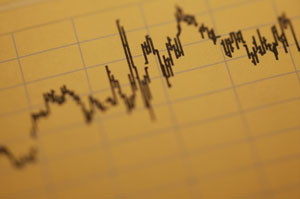A Tool to Gauge the Health of Financial Markets

How does one take the temperature of financial markets? One tool is something called a financial conditions index, which is an indicator of financial stress.
Interest in this type of index grew after the housing bubble burst and the subsequent financial crisis led to the worst recession since the Great Depression.
Economist Paulina Restrepo-Echavarria and Research Associate Brian Reinbold looked at how these indexes are constructed and compared some of the most widely used indexes.
The authors noted that the indexes incorporate various financial variables and typically use either a weighted average of those variables or a statistical technique called principal component analysis (PCA).
“The goal is for the index to summarize information about the future using current financial variables, providing insight into the health of financial markets,” they wrote.
Marching in Lockstep?
The authors noted that the five most widely used financial indexes are:
- St. Louis Fed Financial Stress Index (STLFSI)
- Kansas City Financial Stress Index (KCFSI)
- Chicago Fed National Financial Conditions Index (NFCI)
- Bloomberg Financial Conditions Index (BFCI)
- Goldman Sachs Financial Conditions Index (GSFCI)
The table below lists correlations between the indexes themselves and the indexes’ correlations with the CBOE Volatility Index (VIX). The VIX is a popular method to gauge the financial markets. It is based on option prices for the benchmark S&P 500 stock index, and it serves as a measure of market expectations of near-term volatility.
| Cross-Correlations of Financial Conditions Indexes | ||||||
|---|---|---|---|---|---|---|
| STLFSI | KCFSI | NFCI | GSFCI | BFCI | VIX | |
| STLFSI | 1 | 0.73 | 0.72 | 0.47 | 0.58 | 0.69 |
| KCFSI | 0.73 | 1 | 0.95 | 0.48 | 0.89 | 0.86 |
| NFCI | 0.72 | 0.95 | 1 | 0.57 | 0.87 | 0.80 |
| GSFCI | 0.47 | 0.48 | 0.57 | 1 | 0.43 | 0.45 |
| BFCI | 0.58 | 0.89 | 0.87 | 0.43 | 1 | 0.83 |
| VIX | 0.69 | 0.86 | 0.80 | 0.45 | 0.83 | 1 |
| SOURCES: FRED, Federal Reserve Bank of St. Louis; Bloomberg; and authors' calculations. | ||||||
| Federal Reserve Bank of St. Louis | ||||||
Indexes May Move Differently
The authors explained why these indexes may or may not follow each other closely.
- The Kansas City and the Chicago Fed financial indexes are the most correlated since they use many of the same broad categories of financial variables—such as various Treasury and bond-yield spreads—and are constructed using PCA.
- On the other extreme, the Goldman Sachs index is less correlated with the other indexes because it uses a narrower set of financial variables.
Other than the Goldman Sachs index, the other indexes are also strongly correlated to the VIX, which makes sense since they incorporate the VIX, the authors said. (To view how these indexes have moved since 1990, see the chart in the Economic Synopses article, “Financial Conditions Indexes.”)
While some of the indexes have common elements and relatively high correlations, others do not, Restrepo-Echavarria and Reinbold observed.
“As a result, anyone interested in using financial conditions indexes as indicators of financial stress would benefit from looking at several indexes and not just one,” they said.
Additional Resources
- Economic Synopses: Financial Conditions Indexes
- FRED: St. Louis Fed Financial Stress Index
- On the Economy: Invest in Stocks? Depends on Where You Live
- On the Economy: Do Institutional Investors Chase Returns?
Citation
ldquoA Tool to Gauge the Health of Financial Markets,rdquo St. Louis Fed On the Economy, Dec. 26, 2017.
This blog offers commentary, analysis and data from our economists and experts. Views expressed are not necessarily those of the St. Louis Fed or Federal Reserve System.
Email Us
All other blog-related questions

